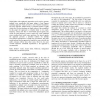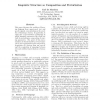ICASSP
2011
IEEE
13 years 10 months ago
2011
IEEE
Currently, the statistical framework based on Hidden Markov Models (HMMs) plays a relevant role in speech synthesis, while voice conversion systems based on Gaussian Mixture Model...
ICASSP
2011
IEEE
13 years 10 months ago
2011
IEEE
This paper presents and evaluates an inverse filtering technique of the speech signal which is based on the Stabilized Weighted Linear Prediction (SWLP) of speech [1]. SWLP empha...
ICASSP
2011
IEEE
13 years 10 months ago
2011
IEEE
While higher order ambisonic approaches can be used to generate multiple zone soundfields, this paper adopts a Least Squares matching approach which provides a more flexible formu...
INTERSPEECH
2010
14 years 1 months ago
2010
This paper proposes a new phase vocoder based method for shape invariant real-time modification of speech signals. The performance of the method with respect voiced and unvoiced s...
TASLP
2002
14 years 6 months ago
2002
We present a spectral domain, speech enhancement algorithm. The new algorithm is based on a mixture model for the short time spectrum of the clean speech signal, and on a maximum a...
TSP
2008
14 years 6 months ago
2008
This paper presents methods for independently modifying the time and pitch scale of acoustic signals, with an emphasis on speech signals. The algorithms developed here use paramet...
TNN
2008
14 years 6 months ago
2008
Separation of speech mixtures, often referred to as the cocktail party problem, has been studied for decades. In many source separation tasks, the separation method is limited by t...
ICASSP
2010
IEEE
14 years 7 months ago
2010
IEEE
Artificial bandwidth extension (ABWE) of speech signals aims to estimate wideband speech (50 Hz – 7 kHz) from narrowband signals (300 Hz – 3.4 kHz). Applying the source-filt...
ICASSP
2010
IEEE
14 years 7 months ago
2010
IEEE
It has long been considered a desirable goal to be able to construct an intelligible speech signal merely by observing the talker in the act of speaking. Past methods at performin...
ACL
1996
14 years 8 months ago
1996
This paper discusses the problem of learning language from unprocessed text and speech signals, concentrating on the problem of learning a lexicon. In particular, it argues for a ...


